

Regturbjen
How do living things change their environments? Think about your day, from when you wake up, to where you spend your day, to your bedtime routine at night.
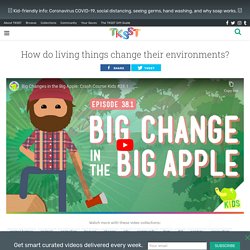
Crash Course Kids asks, “What pieces of it are a result of human intervention? Where did these pieces come from?” What did it take for these pieces to be made? DK Earth: Human Impact. Over six billion people live on planet Earth. As the population grows, we are taking more and more land to live and using more of the world’s natural resources. Many human activities also produce POLLUTION, which is damaging the Earth’s environment.
Since farming began, 10,000 years ago, many wild landscapes have been transformed to create fields for crops and raising animals. Swamps and coastal marshes have been drained. Forests have been felled and grasslands have been plowed. Human Impact on the Environment. Pbslearningmedia. Youth on every continent united in strikes to demand climate action. Young people from more than 150 countries skipped school in a show of unity on Friday, September 20.
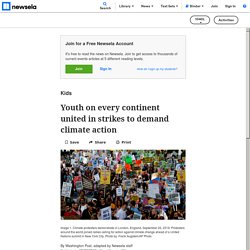
It was part of another series of global climate protests. They urged world leaders to act more quickly to combat climate change. The protests started in Australia where an estimated 300,000 young people in the cities took to the streets. Similar scenes soon began unfolding in towns and cities across the globe, from small island nations such as Kiribati to booming cities like Mumbai, India. Protesters gathered in small groups in Africa and in swelling masses in European capitals. In London, England, thousands marched by the Houses of Parliament. Martha Lickman, a 13-year-old Londoner, clutched a sign that read "Oceans are rising and so are we. " "We're doing our bit, eating less meat, using less plastic," she said, "but it's still on the government to do something.
" Outside Washington, D.C., students at Montgomery Blair High School in Silver Spring, Maryland, walked out of class. Kids’ world climate strikes demand that warming stop, fast. Listen up, grown-ups around the world: You’ve failed us.
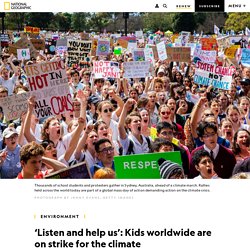
That is the message millions of young people from Sydney to Warsaw to London and beyond carried to the streets on Friday, as they skipped school to stage strikes demanding urgent action on climate change. The global strike is the third this year and involved more than 3,000 protests, according to Fridays for Future, the group that organized them. The strike in New York, where 1.1 million students were excused from school, comes ahead of a pair of climate meetings at the United Nations–the first-ever Youth Summit on Saturday and a one-day Climate Action Summit of the General Assembly on Monday. Striking for change The New York protest was led by Greta Thunberg, the 16-year-old Swedish high school student who has become the face of the fast-growing youth movement that has taken hold in more than 200 nations. That is not why the crowds turned out in the streets, she added. Thunberg delivered a similar message to the U.S.
It's personal. Global youth climate strike: What the protests look like around the world. This story is part of Covering Climate Now, a global collaboration of more than 250 news outlets to strengthen coverage of the climate story.
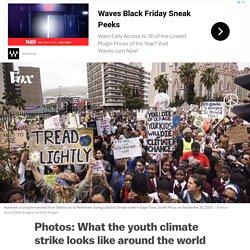
Friday may be remembered as the largest global demonstration ever in the fight against climate change. Inspired by Swedish climate activist Greta Thunberg, young people around the world have organized to skip school and protest in the street over the climate crisis and the adults who aren’t doing enough to transition off fossil fuels. Thunberg and her group Fridays for Future aren’t alone: They’ll be joined by adult climate activists, indigenous groups, workers from companies like Amazon and Google, and really anyone who feels like the world is overdue for dramatic action on climate change.
The event is truly global: There are 2,500 events scheduled in over 150 countries. Let’s take a look at what’s happening around the globe. Afghanistan Australia Bangladesh Belgium Chile China El Salvador France Germany Greece India Indonesia Japan Netherlands Nigeria Pakistan. Global climate strikes: Millions of children take part in protests to help protect the planet - CBBC Newsround. These students were protesting in the Indian city of Mumbai Millions of children around the world have been taking part in a global climate change protest today - it's thought to be the biggest ever!

Protestors from over 150 different countries have taken part in demonstrations aiming to put pressure on governments and decision-makers to do more about climate issues. Smithsonian Ocean. Parasitism in the Tundra. Symbiotic Relationships in the Rain Forest. Because the rain forest is a very diverse habitat, it contains many different species of plants and animals in close proximity to each other.
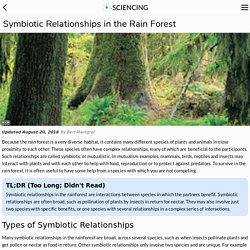
These species often have complex relationships, many of which are beneficial to the participants. Such relationships are called symbiotic or mutualistic. In mutualism examples, mammals, birds, reptiles and insects may interact with plants and with each other to help with food, reproduction or to protect against predators. To survive in the rain forest, it is often useful to have some help from a species with which you are not competing. TL;DR (Too Long; Didn't Read)